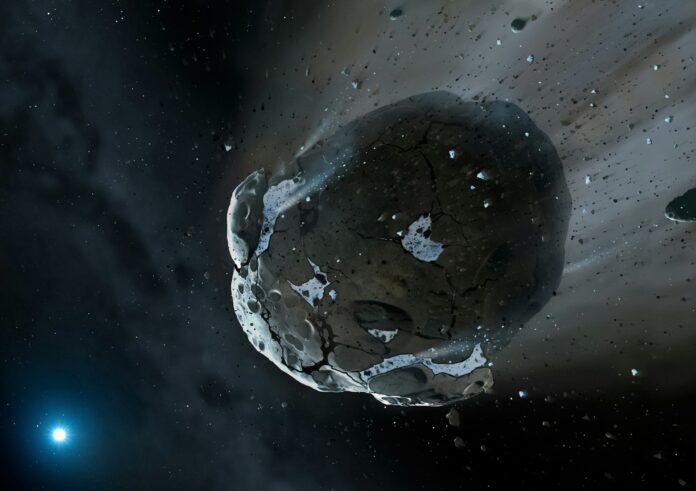The newly discovered asteroid, larger than the Great Pyramid of Giza, makes a close approach without posing a threat
In a celestial spectacle that captured astronomers’ attention worldwide, asteroid 2024 MK, comparable in size to a 40-story skyscraper and larger than the Great Pyramid of Giza, zoomed past Earth on Saturday, June 29. Discovered just two weeks prior by astronomers in South Africa, this massive space rock came within approximately 184,000 miles (295,000 kilometres) of our planet, about three-quarters of the distance to the moon.
Named after its discovery year and sequence, 2024 MK measures an estimated 480 feet (146 meters) across. As it approached, it hurtled through space at a staggering speed of around 21,000 mph (34,000 km/h). Despite its size and close proximity, NASA assured the public that this asteroid posed no danger to Earth. Classified as a “potentially hazardous asteroid,” mainly due to its size and intersecting orbit with Earth, 2024 MK maintained a safe trajectory, heading back towards the asteroid belt located between Mars and Jupiter.
The close encounter coincided with World Asteroid Day, observed annually on June 30 to raise awareness about asteroid impacts and planetary defence. This event also served as a reminder of historical asteroid impacts, such as the 1908 Tunguska event in Siberia, which devastated over 830 square miles (2,150 square kilometres) of forest.
Astronomers and space agencies, including NASA, closely monitored 2024 MK and thousands of other Near-Earth Objects (NEOs) to track their orbits and assess potential threats to our planet. The discovery and observation of such asteroids are crucial in developing strategies for planetary defence and understanding the dynamics of our solar system.
While 2024 MK safely traversed Earth’s vicinity this time, its passage highlighted ongoing efforts to enhance asteroid detection and preparedness for potential impacts. Public interest in astronomy and planetary science surged, with many people following the asteroid’s journey through live streams and updates from observatories worldwide.
Analysis:
Political Perspective: The event underscores the importance of international cooperation in space surveillance and planetary defence strategies. Governments and space agencies collaborate to monitor NEOs and develop protocols for potential impact scenarios, emphasizing global security in the face of cosmic threats.
Social Perspective: Public interest in asteroid flybys reflects growing societal awareness of space exploration and celestial events. Events like World Asteroid Day stimulate conversations about planetary safety, scientific exploration, and humanity’s place in the universe, fostering a sense of unity and curiosity across diverse communities.
Racial Perspective: There are no explicit racial implications in this astronomical event. However, the inclusive nature of scientific exploration and space discovery encourages participation and interest from diverse racial and ethnic backgrounds, promoting equality in accessing knowledge and opportunities in STEM fields.
Gender Perspective: Similarly, gender equality in astronomy and space sciences benefits from inclusive outreach and educational initiatives. The event highlights the contributions of scientists and researchers of all genders in understanding celestial phenomena and advancing planetary defence capabilities, promoting gender diversity in STEM disciplines.
Economic Perspective: Investments in asteroid detection and planetary defence technologies stimulate economic growth in aerospace industries and technological innovation. Governments and private sectors fund research and development of space observation tools, satellite technologies, and asteroid deflection strategies, contributing to job creation and scientific advancement globally.
